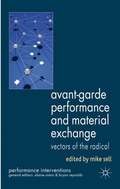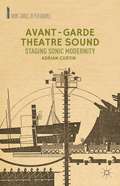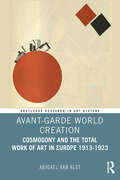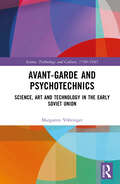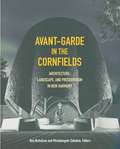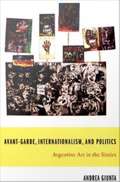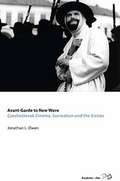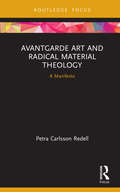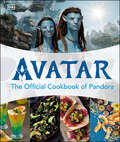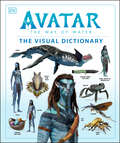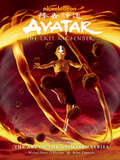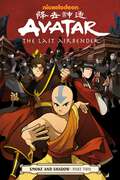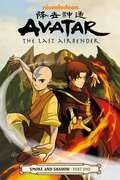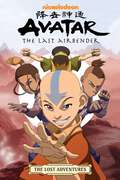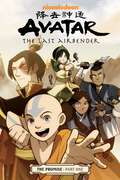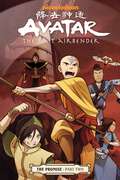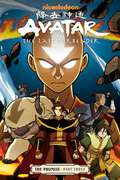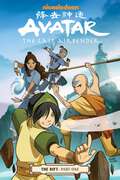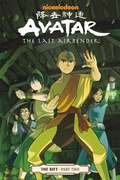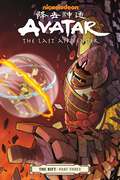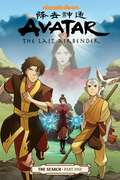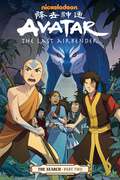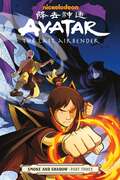- Table View
- List View
Avant-Garde Performance and Material Exchange
by Mike SellAssembling a remarkable group of scholars, these essays explore how the circulation and exchange of 'vectors of the radical' shape the avant-garde. Mapping the movement of scripts, theatre activists, performances, and other material entities, they provide unprecedented perspectives on the transnational performance culture of the avant-garde.
Avant-Garde Theatre Sound
by Adrian CurtinSound experimentation by avant-garde theatre artists of the late-nineteenth and early-twentieth centuries is an important but ignored aspect of theatre history. Curtin explores how artists engaged with the sonic conditions of modernity through dramatic form, characterization, staging, technology, performance style, and other forms of interaction.
Avant-Garde World Creation: Cosmogony and the Total Work of Art in Europe 1913-1923 (Routledge Research in Art History)
by Abigael van AlstThis book explores the widespread fascination with world creation among early twentieth-century artists and examines those trends within the European avant-garde.The book reflects on what ‘the world’ looks and feels like before and after World War One—and thus also concerns creativity and destruction alike in the context of modernity. Over the course of three chapters, the author focusses on works in which avant-garde artists combine and experiment with various arts and media to create alternative narratives of the world’s creation. These works include three canonized ‘total works of art’: Der Weltbaumeister (The World’s Master Builder, 1920), an illustrated book imagined as an architectural play by the Expressionist architect Bruno Taut; the Futurist opera Победа над Cолнцем (Victory Over the Sun, 1913) by Aleksei Kruchenykh, Velimir Khlebnikov, Kazimir Malevich and Mikhail Matiushin; and the Cubist ballet La Création du monde (The Creation of the World, 1923) by Blaise Cendrars, Fernand Léger, Darius Milhaud and Jean Börlin. Providing new readings of these classic works that dive deeply into the avant-garde’s inter-artistic search for new modes of mediation as well as its dialogue with science, politics and technology, Abigael van Alst demonstrates how each of these artworks staged a cosmogony—an alternative story of the universe's creation—which, simultaneously, experimentally and critically recounted the story of modernity.This new book is ideal for researchers and scholars in History of Art, Modernism, and Comparative Literature.
Avant-Garde and Psychotechnics: Science, Art and Technology in the Early Soviet Union (Science, Technology and Culture, 1700-1945)
by Margarete VöhringerAvant-Garde and Psychotechnics presents an innovative look at the Russian avant-garde and its cultural encounters with the sciences in the 1920s. The book examines some of the lesser known entanglements between architects, filmmakers and philosophers, on the one hand, and experimental psychologists and physiologists on the other. In Russia, famous avant-garde artists, such as El Lissitzky, Vassily Kandinsky and Dziga Vertov, helped propagate a movement referred to as "psychotechnics" that was emerging at the time in Germany and the United States and eventually led to a "psychotechnical boom." At the end of the story told in the book, it becomes clear that this boom continues to the present day. By analyzing concrete projects undertaken by Russian artists and scientists in cooperation with one another, and by drawing on as-yet-unpublished archival material, Avant-Garde and Psychotechnics challenges the established notion of socialist sciences. At the same time, it provides an entirely new picture of what was thought to be modern art, thereby demonstrating that artistic experimentation had much more than a mere metaphorical meaning in Russian arts in the 1920s. In 2007 Avant-Garde and Psychotechnics was acknowledged with an award for interdisciplinary research by the Wilhelm-Ostwald-Society, Großbothen. In 2011 the book received funding from the VolkswagenStiftung to be translated into English and Russian (the Russian edition was published by NLO books in 2019). The original German edition also received favorable reviews in NZZ, NTM, Derive, Junge Welt and Sehepunkte.
Avant-Garde in the Cornfields: Architecture, Landscape, and Preservation in New Harmony
by Michelangelo Sabatino Ben NicholsonA close examination of an iconic small town that gives boundless insights into architecture, landscape, preservation, and philanthropyAvant-Garde in the Cornfields is an in-depth study of New Harmony, Indiana, a unique town in the American Midwest renowned as the site of two successive Utopian settlements during the nineteenth century: the Harmonists and the Owenites. During the Cold War years of the twentieth century, New Harmony became a spiritual &“living community&” and attracted a wide variety of creative artists and architects who left behind landmarks that are now world famous. This engrossing and well-documented book explores the architecture, topography, and preservation of New Harmony during both periods and addresses troubling questions about the origin, production, and meaning of the town&’s modern structures, landscapes, and gardens. It analyzes how these were preserved, recognizing the funding that has made New Harmony so vital, and details the elaborate ways in which the town remains an ongoing experiment in defining the role of patronage in historic preservation.An important reappraisal of postwar American architecture from a rural perspective, Avant-Garde in the Cornfields presents provocative ideas about how history is interpreted through design and historic preservation—and about how the extraordinary past and present of New Harmony continue to thrive today. Contributors: William R. Crout, Harvard U; Stephen Fox, Rice U; Christine Gorby, Pennsylvania State U; Cammie McAtee, Harvard U; Nancy Mangum McCaslin; Kenneth A. Schuette Jr., Purdue U; Ralph Schwarz; Paul Tillich.
Avant-Garde, Internationalism, and Politics: Argentine Art in the Sixties
by Andrea GiuntaThe 1960s were heady years in Argentina. Visual artists, curators, and critics sought to fuse art and politics; to broaden the definition of art to encompass happenings and assemblages; and, above all, to achieve international recognition for new, cutting-edge Argentine art. A bestseller in Argentina, Avant-Garde, Internationalism, and Politics is an examination of the 1960s as a brief historical moment when artists, institutions, and critics joined to promote an international identity for Argentina's visual arts. The renowned Argentine art historian and critic Andrea Giunta analyzes projects specifically designed to internationalize Argentina's art and avant-garde during the 1960s: the importation of exhibitions of contemporary international art, the sending of Argentine artists abroad to study, the organization of prize competitions involving prestigious international art critics, and the export of exhibitions of Argentine art to Europe and the United States. She looks at the conditions that made these projects possible--not least the Alliance for Progress, a U. S. program of "exchange" and "cooperation" meant to prevent the spread of communism through Latin America in the wake of the Cuban Revolution--as well as the strategies formulated to promote them. She describes the influence of Romero Brest, prominent art critic, supporter of abstract art, and director of the Centro de Artes Visuales del Instituto Tocuato Di Tella (an experimental art center in Buenos Aires); various group programs such as Nueva Figuracin and Arte Destructivo; and individual artists including Antonio Berni, Alberto Greco, Len Ferrari, Marta Minujin, and Luis Felipe No. Giunta's rich narrative illuminates the contentious postwar relationships between art and politics, Latin America and the United States, and local identity and global recognition.
Avant-garde To New Wave
by Jonathan L. OwenThe cultural liberalization of communist Czechoslovakia in the 1960s produced many artistic accomplishments, not least the celebrated films of the Czech New Wave. This movement saw filmmakers use their new freedom to engage with traditions of the avant-garde, especially Surrealism. This book explores the avant-garde's influence over the New Wave and considers the political implications of that influence. The close analysis of selected films, ranging from the Oscar-winning Closely Observed Trains to the aesthetically challenging Daisies, is contextualized by an account of the Czech avant-garde and a discussion of the films' immediate cultural and political background.
Avantgarde Art and Radical Material Theology: A Manifesto (Routledge Focus on Religion)
by Petra Carlsson RedellTheological thought has long been focused on the meaning to be found in our existence, but it has tended to neglect what it might offer to those seeking how to prolong and improve our physical existence in this world. In conversation with twentieth-century materialist art and thought, this book presents a radical theology that engages directly with the political and ecological issues of our time. The book introduces a new thinker to the theological sphere, Russian avantgarde artist Liubov Popova (1889–1924). She was a woman acknowledged for her artistic and intellectual talent and yet is never discussed in relation to the twentieth-century thinkers with whom her ideas have obvious connections. Popova’s art and thought are discussed together with thinkers like Walter Benjamin, Donna Haraway, Gilles Deleuze and Paul Tillich, along with ecotheological and theopolitical perspectives. Inspired by the activist creativity of avantgarde art, the book’s final chapter, playfully yet with deadly seriousness, presents a manifesto for radical theology today. This is a work of theological activism that demonstrates the benefit of allowing new voices into the conversations around art, spirituality and our planet. As such, it will be of keen interest to academics in Theology, Religion and the Arts and the Philosophy of Religion.
Avatar The Official Cookbook of Pandora
by DKBe transported to the breathtaking locations of Avatar and Avatar: The Way of Water with more than 50 delicious recipes inspired by the lush biomes of Pandora.Experience the Hallelujah Mountains&‘ High Camp, the secret cave encampment of the Omatikaya, the reef atolls of the Metkayina clan and sacred sites such as the Tree of Souls in a new, mouthwatering way through carefully curated recipes inspired by the peaceful Na&’vi lifestyle. Feast on everything from Pandoran pancakes and Sully family shakshuka, to delicious frittatas, fish dishes, soups, salads, and stews, topped off with Na&’vi deserts, sunrise cocktails, and frozen mocktails.This official cookbook conjures the magical landscapes, flora, fauna, and atmosphere of James Cameron&’s Avatar, all lavishly photographed for movie fans and foodies alike.
Avatar The Way of Water The Visual Dictionary
by Ben Procter Joshua Izzo Zachary Berger Dylan Cole Reymundo PerezDive into the depths of Avatar: The Way of Water with this definitive guide. Created in close collaboration with James Cameron&’s Lightstorm Entertainment and written by experts who worked on the film, this authoritative book is packed with stunning exclusive details. This must-have visual guide showcases the characters, creatures, vehicles, weapons, and locations from the latest adventure in Pandora. Meet the next generation of Jake Sully and Neytiri&’s family, including the mysterious Kiri and the heroic Neteyam, and their brave new allies among the Metkayina clan. Discover the majestic tulkun, speedy skimwings, and the other fauna and flora of Pandora&’s oceans. Examine the latest fearsome RDA vehicles and the specialist recom troops under Colonel Quaritch&’s command. Uncover the inner workings of Bridehead City and the sacred Cove of the Ancestors. With a foreword by Sigourney Weaver, Avatar: The Way of Water: The Visual Dictionary is the perfect gift for Avatar fans of all ages. © 2022 20th Century Studios.
Avatar: The Last Airbender The Art of the Animated Series (Second Edition)
by Michael Dante DiMartino Bryan KonietzkoThe animated series Avatar: The Last Airbender has inspired millions of fans and industry professionals alike. Now, to celebrate the anniversary of the show's first airing comes this deluxe second edition of Avatar: The Last Airbender--The Art of the Animated Series!Join series creators Bryan Konietzko and Michael Dante DiMartino for an unprecedented behind-the-scenes look at hundreds of pieces of concept, design, and production art from the show. You'll be taken on a guided tour through the development of this smash-hit television series in this deluxe edition that includes: • Stunning new cover art by Bryan Konietzko, with an extra special cover treatment! ! • Eight pages of new material, plus an all-new introduction by award-winning Avatar: The Last Airbender comics series writer Gene Luen Yang!
Avatar: The Last Airbender - Smoke and Shadow Part 2
by Gene Luen YangWith the disappearances of children in the Fire Nation capital, Avatar Aang and his friends are doing everything they can to find out who—or what—is responsible.Aang and Zuko must work together to keep the peace, but the emergence of the New Ozai Society, and the appearance of the mysterious Kemurikage of legend, may prove to be too much even for the Avatar when the true culprit of the kidnappings is revealed!* The official continuation of Airbender from its creators, Michael Dante DiMartino and Bryan Konietzko!* The perfect companion to The Legend of Korra!
Avatar: The Last Airbender - Smoke and Shadow Part One (Avatar: The Last Airbender)
by Gene Luen YangThe Fire Nation is threatened by a prophecy told by the Kemurikage--mysterious figures thought only to exist in legend--remove Zuko from the throne or the country will perish!Avatar Aang and his friends escort Zuko and his family back to the capitol completely unaware of the looming threat growing in the city. Unrest is brewing as the New Ozai Society prepares to make its move against the crown, and children begin to go missing from their homes under mysterious circumstances! Written and drawn by the creative team behind the best-selling The Promise, The Search and The Rift, Gene Luen Yang and Gurihiru, in collaboration with Avatar: The Last Airbender and Legend of Korra creators Michael Dante DiMartino and Bryan Konietzko, this is the ultimate continuation of Avatar and the perfect companion to Legend of Korra!
Avatar: The Last Airbender - The Lost Adventures (Avatar: The Last Airbender)
by VariousFor three years, millions of eager fans tuned in to watch new episodes of Nickelodeon's hit animated series Avatar: The Last Airbender. Ever since, fans have been hungry for more—and now their wait is finally over!This volume collects the long-out-of-print, fan-favorite comics previously published in Nickelodeon Magazine and with the Airbender DVDs, plus over seventy brand-new comics pages. That's twenty-six stories set in Airbender continuity, by a host of top-notch talent, many of whom worked on the original animated series!* A must-have for any Airbender fan!* Twenty-six in-continuity stories, plus bonus content!* The latest release in an ongoing partnership between Nickelodeon and Dark Horse, to bring you the very best in Airbender books!
Avatar: The Last Airbender - The Promise Part 1 (Avatar: The Last Airbender)
by Gene Luen YangThe wait is over! Ever since the conclusion of Avatar: The Last Airbender, its millions of fans have been hungry for more—and it's finally here!This series of digests rejoins Aang and friends for exciting new adventures, beginning with a faceoff against the Fire Nation that threatens to throw the world into another war, testing all of Aang's powers and ingenuity!* The continuation of Airbender and the link to its upcoming sequel, Legend of Korra!* Written by Gene Luen Yang, author of the National Book Award-nominated American Born Chinese.
Avatar: The Last Airbender - The Promise Part 2 (Avatar: The Last Airbender)
by Gene Luen YangAang and Katara are working tirelessly for peace when an impasse between Fire Lord Zuko and Earth King Kuei over Fire Nation colonies within the borders of the Earth Nation threatens to plunge the world back into war! Meanwhile, Sokka must help Toph prepare her hapless first class of metalbending students to defend their school against a rival class of firebenders! * Written by Eisner winner and National Book Award nominee Gene Luen Yang (American Born Chinese).
Avatar: The Last Airbender - The Promise Part 3 (Avatar: The Last Airbender)
by Gene Luen YangAvatar: The Last Airbender creators Michael Dante DiMartino and Bryan Konietzko bring The Promise to its explosive conclusion! The Harmony Restoration Movement has failed, and the four nations are plunged back into war! In the midst of the battle, can Aang and Fire Lord Zuko mend the rift between them, or will Aang be forced to take actions that can't be undone? Written by Eisner winner and National Book Award nominee Gene Luen Yang (American Born Chinese) and drawn by Gurihiru(Thor and the Warriors Four), this is the adventure Avatar fans have been craving!
Avatar: The Last Airbender - The Rift Part 1 (Avatar: The Last Airbender)
by Gene Luen YangAvatar Aang asks his friends to help him honor Yangchen's Festival—one of the highest Air Nomad holidays, which hasn't been celebrated in over one hundred years. But cryptic visits from the spirit of Avatar Yangchen herself lead Aang to discover a jointly owned Fire Nation and Earth Kingdom refinery—operating on land sacred to the Airbenders! Is this the cause of the pollution Aang finds there, or is a more mysterious menace afoot? * The official continuation of Airbender from the original series creators! * Continues to top the sales charts! * The perfect companion to The Legend of Korra! "One of the best new pop culture mythologies to debut in the last decade."—Kotaku "A fantastic glimpse into the post-series universe."—Bleeding Cool
Avatar: The Last Airbender - The Rift Part 2 (Avatar: The Last Airbender)
by Gene Luen Yang Michael Dante DiMartinoTeam Avatar find themselves up to their necks in trouble as mysterious forces threaten to destroy land once sacred to the Airbenders! While Aang journeys to the spirit world in search of clues, Toph faces off against her own past!* The official continuation of Airbender from its creators, Michael Dante DiMartino and Bryan Konietzko!* Avatar: The Last Airbender—The Search continues to top the sales charts!* The perfect companion to The Legend of Korra!
Avatar: The Last Airbender - The Rift Part 3 (Avatar: The Last Airbender)
by Gene Luen YangWritten and drawn by the creative team behind the best-sellingThe Promise and The Search, in collaboration with the creators ofAvatar: The Last Airbender and The Legend of Korra, this is the ultimate continuation of Avatar and the perfect companion toKorra!* The official continuation of Airbender from its creators!&“As with much of what the show and comic series have done, it&’s nothing like what I expected, and is still so satisfying.&”—Fandom Post
Avatar: The Last Airbender - The Search Part 1 (Avatar: The Last Airbender)
by Gene Luen YangFor years, fans of Avatar: The Last Airbender and The Legend of Korra have burned with one question—what happened to Fire Lord Zuko's mother? Finding a clue at last, Zuko enlists the aid of Team Avatar—and the most unlikely ally of all—to help uncover the biggest secret of his life. * This is the perfect companion to The Legend of Korra! * The official continuation of Airbender from its creators!
Avatar: The Last Airbender - The Search Part 2 (Avatar: The Last Airbender)
by Gene Luen YangIn search of their long-lost mother, Fire Lord Zuko and his deadly and insane sister Azula have brought Avatar Aang and his friends into a mysterious forest, but what they discover within may be more than they can face. Will they too be lost in these woods forever? * Perfect companion to Legend of Korra! * The official continuation of Airbender from its creators. "A fantastic glimpse into the post-series universe... " —Bleeding Cool
Avatar: The Last Airbender - The Search Part 3 (Avatar: The Last Airbender)
by Gene Luen YangAvatar Aang travels to the spirit world to parley with an ancient power; bringing Fire Lord Zuko ever closer to discovering the truth about his mother's fate—and his own past. Yet Zuko's sister Azula is becoming increasingly dangerous; threatening to ruin everything that Zuko; Aang; Katara; and Sokka have struggled to achieve on their search! * The official continuation of Airbender from its creators; Michael Dante DiMartino and Bryan Konietzko!
Avatar: The Last Airbender- Smoke and Shadow Part Three
by Gene Luen YangChildren are disappearing in the Fire Nation capital! Avatar Aang and his friends are doing everything in their power to save them—but will it be enough?And worse, when Azula—the mad sister of Fire Lord Zuko—appears on the scene, Zuko locks down the city to catch her, igniting fear and riots in the streets! Will Zuko follow in his evil father&’s footsteps in order to save those he holds dear?* The official continuation of Airbender from its creators, Michael Dante DiMartino and Bryan Konietzko!
Avatar: The Last Airbender--North and South Part One (Avatar: The Last Airbender: North and South #1)
by VariousFrom National Ambassador for Young People&’s Literature, Eisner Award winner, and #1 New York Times bestseller Gene Yang!When Aang leaves to aid Zuko with the Kemurikage, Katara and Sokka return to the Southern Water Tribe by themselves. Katara is shocked to find that her beloved village has become a bustling city, with none other than their father, Hakoda, in charge! A northerner named Malina seems to be behind this change, pushing the North and South to be more unified . . . but what are her true goals?* The official continuation of Airbender from its creators, Michael Dante DiMartino and Bryan Konietzko!
